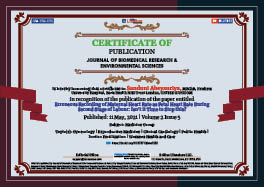Ferha Saeed, Sanduni Abeysuriya* and Edwin Chandraharan
Volume2-Issue5
Dates: Received: 2021-05-05 | Accepted: 2021-05-10 | Published: 2021-05-11
Pages: 315-319
Abstract
Electronic Fetal Heart Rate (FHR) monitoring is recommended to assess fetal well-being during labour in high risk pregnancies. This Cardiotocograph (CTG) monitoring relies on the ultrasound technology with the limitation of signal loss in 15% to 40% of the cases [1]. In the earlier versions of these CTG monitors, fetal heart tracings were generally of reasonable quality with many artefacts and some degree of occasional large signal noise. Subsequent models were improved by signal modulation and autocorrelation. Although, these new methodologies of signal processing have reduced the signal loss, the issues of inadvertent monitoring of the maternal heart rate as fetal heart rate and inaccurate evaluations of baseline fetal heart rate (i.e. doubling or halving) continue to pose difficulties during intrapartum fetal heart rate monitoring.
FullText HTML
FullText PDF
DOI: 10.37871/jbres1233
Certificate of Publication

Copyright
© 2021 Saeed F, et al. Distributed under Creative Commons CC-BY 4.0
How to cite this article
Saeed F, Abeysuriya S, Chandraharan E. Erroneous Recording of Maternal Heart Rate as Fetal Heart Rate During Second Stage of Labour: Isn’t it Time to Stop this? J Biomed Res Environ Sci. 2021 May 11; 2(5): 315-319. doi: 10.37871/jbres1233, Article ID: jbres1233
Subject area(s)
References
- Spencer JA, Belcher R, Dawes GS. The influence of signal loss on the comparison between computer analyses of the fetal heart rate in labour using pulsed Doppler ultrasound (with autocorrelation) and simultaneous scalp electrocardiogram. Eur J Obstet Gynecol Reprod Biol. 1987 May;25(1):29-34. doi: 10.1016/0028-2243(87)90089-x. PMID: 3297840.
- Nageotte MP. Avoiding 5 common mistakes in FHR monitoring. Contemp Ob Gyn. 2007;52(5):50-55.
- Gonçalves H, Rocha AP, Ayres-de-Campos D, Bernardes J. Internal versus external intrapartum foetal heart rate monitoring: the effect on linear and nonlinear parameters. Physiol Meas. 2006 Mar;27(3):307-19. doi: 10.1088/0967-3334/27/3/008. Epub 2006 Feb 6. PMID: 16462016.
- Nunes I, Ayres-de-Campos D, Costa-Santos C, Bernardes J. Differences between external and internal fetal heart rate monitoring during the second stage of labor: a prospective observational study. J Perinat Med. 2014 Jul;42(4):493-8. doi: 10.1515/jpm-2013-0281. PMID: 24445232.
- Nurani R, Chandraharan E, Lowe V, Ugwumadu A, Arulkumaran S. Misidentification of maternal heart rate as fetal on cardiotocography during the second stage of labor: the role of the fetal electrocardiograph. Acta Obstet Gynecol Scand. 2012 Dec;91(12):1428-32. doi: 10.1111/j.1600-0412.2012.01511.x. Epub 2012 Sep 18. PMID: 22881463.
- Reinhard J, Hayes-Gill BR, Schiermeier S, Hatzmann H, Heinrich TM, Louwen F. Intrapartum heart rate ambiguity: a comparison of cardiotocogram and abdominal fetal electrocardiogram with maternal electrocardiogram. Gynecol Obstet Invest. 2013;75(2):101-8. doi: 10.1159/000345059. Epub 2013 Jan 17. PMID: 23328351.
- Neilson DR Jr, Freeman RK, Mangan S. Signal ambiguity resulting in unexpected outcome with external fetal heart rate monitoring. Am J Obstet Gynecol. 2008 Jun;198(6):717-24. doi: 10.1016/j.ajog.2008.02.030. Epub 2008 Apr 2. PMID: 18377859.
- RCOG. The use of electronic fetal monitoring. The use of cardiotocography in intrapartum fetal surveillance. Evidence-based clinical guideline number 8. Clinical Effectiveness Support Unit. London: RCOG Press; 2001.
- Chauhan SP, Klauser CK, Woodring TC, Sanderson M, Magann EF, Morrison JC. Intrapartum nonreassuring fetal heart rate tracing and prediction of adverse outcomes: interobserver variability. Am J Obstet Gynecol. 2008 Dec;199(6):623.e1-5. doi: 10.1016/j.ajog.2008.06.027. Epub 2008 Jul 30. PMID: 18667185.
- Medical Device Alert Ref MDA/2010/054. Device-Fetal monitor/cardiotocograph. Medicines and Healthcare Products Regulatory Agency; 2010.
- McDonnell S, Chandraharan E. Fetal Heart Rate Interpretation in the Second Stage of Labour: Pearls and Pitfalls. British Journal of Medicine & Medical Research. 2015;7(12): 957-970.
- Bhuinneain MN, McKenna P, O’Herlihy C, Sugrue D. The domain analysis of maternal heart rate variability in normal pregnancy-A longitudinal study [Abstract No. 667]. American Journal of Obstetrics and Gynecology. 2000;182:200.
- Söhnchen N, Melzer K, Tejada BM, Jastrow-Meyer N, Othenin-Girard V, Irion O, Boulvain M, Kayser B. Maternal heart rate changes during labour. Eur J Obstet Gynecol Reprod Biol. 2011 Oct;158(2):173-8. doi: 10.1016/j.ejogrb.2011.04.038. Epub 2011 Jun 8. PMID: 21641105.
- Murray M. Antepartal and intrapartal fetal monitoring (2nd Ed.). Albuquerque, NM: Learning Resources International. 1997.
- Afors K, Chandraharan E. Use of continuous electronic fetal monitoring in a preterm fetus: clinical dilemmas and recommendations for practice. J Pregnancy. 2011;2011:848794. doi: 10.1155/2011/848794. Epub 2011 Sep 13. PMID: 21922045; PMCID: PMC3172974.
- Sherman DJ, Frenkel E, Kurzweil Y, Padua A, Arieli S, Bahar M. Characteristics of maternal heart rate patterns during labor and delivery. Obstet Gynecol. 2002 Apr;99(4):542-7. doi: 10.1016/s0029-7844(01)01785-9. PMID: 12039107.
- Yamashiro V, Scales P, Ng H. Fetal heart rate monitoring casebook: heart rate monitoring in a case of antepartum stillbirth. J Perinatol. 1988 Summer;8(3):276-81. PMID: 3225671.
- Herbert WN, Stuart NN, Butler LS. Electronic fetal heart rate monitoring with intrauterine fetal demise. J Obstet Gynecol Neonatal Nurs. 1987 Jul-Aug;16(4):249-52. doi: 10.1111/j.1552-6909.1987.tb01581.x. PMID: 3650324.
- Hoh JK, Park MI, Park YS, Koh SK. The significance of amplitude and duration of fetal heart rate acceleration in non-stress test analysis. Taiwan J Obstet Gynecol. 2012 Sep;51(3):397-401. doi: 10.1016/j.tjog.2012.07.014. PMID: 23040924.
- Lauletta AL, Nomura RM, Miyadahira S, Francisco RP, Zugaib M. Transient accelerations of fetal heart rate analyzed by computerized cardiotocography in the third trimester of pregnancy. Rev Assoc Med Bras (1992). 2014 May-Jun;60(3):270-5. doi: 10.1590/1806-9282.60.03.017. PMID: 25004274.
- Cahill Alison G, Odibo Anthony, Roehl Kimberly, Macones George. Electronic fetal heart rate patterns in the second stage of labor: Utility of the NICHD nomenclature. American Journal of Obstetrics and Gynecology. 2012;274-S275. https://bit.ly/3bhlAvn
- Holzmann M, Wretler S, Nordström L. Absence of accelerations during labor is of little value in interpreting fetal heart rate patterns. Acta Obstet Gynecol Scand. 2016 Oct;95(10):1097-103. doi: 10.1111/aogs.12939. Epub 2016 Jul 26. PMID: 27301645.
- Gonçalves H, Pinto P, Silva M, Ayres-de-Campos D, Bernardes J. Electrocardiography versus photoplethysmography in assessment of maternal heart rate variability during labor. Springerplus. 2016 Jul 15;5(1):1079. doi: 10.1186/s40064-016-2787-z. PMID: 27462527; PMCID: PMC4945517.






























































